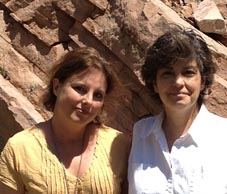Sherlock Holmes and the Case of the Scientist-Detectives: Sleuthing the Past, Projecting the Future
As savvy as Sherlock was, his insights pale compared to the ingenious techniques used by paleoscientists in reconstructing past environmental conditions. Drs. Rusty Low and Carole Mandryk presented these techniques in an interactive webinar showing how fossils, rocks and chemical information (the so-called biogeochemical proxy data) evidence Earth system processes on time scales that even Sherlock didn't know to exist. By the end of the webinar, Dr. Low and Dr. Mandryk made evident that the patterns of contemporary climate change we see today can't be understood without the backstory provided by paleoclimate research.

Drs. Low and Mandryk bonded while in grad school, looking through microscopes at fossil pollen grains in the paleoenvironmental laboratory at the University of Alberta, Edmonton. Dr. Low was examining evidence for the peopling of the New World through the ice-free corridor at the end of the most recent ice age (Pleistocene), and Dr. Mandryk was looking at pollen from a Neanderthal cave in South Germany that was supposed to end in a reconstruction of warm and cool intervals during the last ice age
Dr. Low is a lead instructor and Associate Professor, Masters of Applied Science Program, Specialization in Science for Educators, University of Nebraska, and a senior Earth Scientist for the Institute for Global Environmental Strategies. She was a graduate fellow in the Paleorecords of Global Change program, University of Minnesota, where she earned her Ph.D. in 2001. She is a mom of two kids, Shelby and Max, who endured fieldwork with their parents in Europe and SW Asia.
Dr. Carole Mandryk served as an associate professor at Harvard and University of Hawaii before establishing 3C2E, a climate change research, education and evaluation firm in Boulder, Colorado. She is a mom of two boys, Nicholas and Zachary, who also spent quality parent-child time in geological field camps as kids.
Education
Webinar Archives Education ResourcesStewardship
Supporting Stewardship Past Projects Focus Area Resources Applying for Funding
Search Education
Get Social
Last updated: 06/16/24
Author: NOAA
How to cite this article
